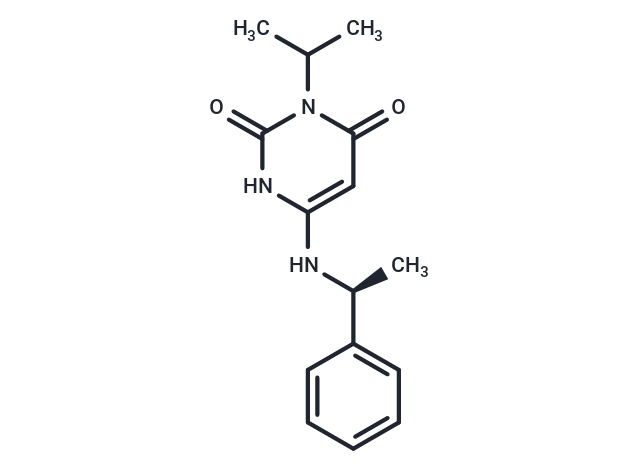Shopping Cart
- Remove All
 Your shopping cart is currently empty
Your shopping cart is currently empty

Mavacamten (MYK-461) is an orally bioavailable inhibitor of cardiac myosin ATPase,( IC50s of 490, 711 nM for bovine cardiac and human cardiac, respectively)

| Pack Size | Price | Availability | Quantity |
|---|---|---|---|
| 1 mg | $40 | In Stock | |
| 5 mg | $73 | In Stock | |
| 10 mg | $108 | In Stock | |
| 25 mg | $189 | In Stock | |
| 50 mg | $268 | In Stock | |
| 100 mg | $376 | In Stock | |
| 1 mL x 10 mM (in DMSO) | $80 | In Stock |
| Description | Mavacamten (MYK-461) is an orally bioavailable inhibitor of cardiac myosin ATPase,( IC50s of 490, 711 nM for bovine cardiac and human cardiac, respectively) |
| Targets&IC50 | ATPase (human cardiac myosin):711 nM, ATPase (Bovine cardiac myosin):490 nM |
| In vitro | MYK-461 is found to have an IC50 value of 490 nM in the bovine system, 711 nM in the human system, and 2140 nM in the rabbit system, indicating selectivity of >4-fold for cardiac myosin[1] |
| In vivo | MYK-461 reduces cardiac contractility, prevents left ventricular hypertrophy, and reverses pathologic remodeling. In cats, it relieves left ventricular outflow tract obstruction[2] |
| Animal Research | Five?cats received a combination of alfaxalone and midazolam for anesthetic induction, followed by inhaled isoflurane and oxygen maintenance.?Blood pressure was measured via an automated blood pressure cuff at five-minute intervals with supplementary continuous monitoring by arterial line when arterial access could be obtained.?Following induction of anesthesia, a complete baseline echocardiogram was performed (timepoint #1).?Cats were then treated with atropine 0.04 mg/kg IV, followed by an infusion of isoproterenol 0.04 μg/kg/min IV to elevate heart rate back to pre-anesthetized values and induce the previously observed LVOT obstruction.?After five to seven minutes, a stable heart rate of 200–220 bpm was reached and a complete echocardiogram was performed (timepoint #2).?At the completion of imaging, a ten-minute intravenous infusion of MYK-461 (n = 5) at 0.3 mg/kg/hr IV was started.?Focused echocardiography was performed after five minutes (timepoint #3).?After ten minutes, the MYK-461 infusion rate was lowered to 0.12 mg/kg/hr IV, a blood sample was drawn and an echocardiogram performed (timepoint #4).?If ventricular function remained hypercontractile or within normal limits by visual inspection, another blood sample was obtained and the MYK-461infusion rate was increased to 0.36 mg/kg/hr IV for ten minutes.?Focused echocardiography was performed after five minutes (timepoint #5).?After ten minutes, the MYK-461 infusion rate was lowered to 0.15 mg/kg/hr IV, a blood sample was drawn and an echocardiogram performed (timepoint #6).?Following imaging, the isoproterenol infusion was discontinued.?When heart rate returned to baseline levels (five to seven minutes), a complete echocardiogram was performed on MYK-461 alone (timepoint #7).?Study drug was then discontinued, and animals were awakened, extubated and moved to recovery.?Three of five cats were available to return for a control arm of this experiment after a 6-week washout period.The experiment was completed with identical methodology with the exception that MYK-461 was substituted for vehicle (control) at matched volumes/infusion rates[2]. |
| Alias | SAR439152, MYK-461 |
| Molecular Weight | 273.33 |
| Formula | C15H19N3O2 |
| Cas No. | 1642288-47-8 |
| Smiles | CC(C)n1c(=O)cc(N[C@@H](C)c2ccccc2)[nH]c1=O |
| Relative Density. | 1.19 g/cm3 (Predicted) |
| Storage | Powder: -20°C for 3 years | In solvent: -80°C for 1 year | Shipping with blue ice. | |||||||||||||||||||||||||||||||||||
| Solubility Information | DMSO: 150 mg/mL (548.79 mM), Sonication is recommended. | |||||||||||||||||||||||||||||||||||
Solution Preparation Table | ||||||||||||||||||||||||||||||||||||
DMSO
| ||||||||||||||||||||||||||||||||||||

Copyright © 2015-2025 TargetMol Chemicals Inc. All Rights Reserved.